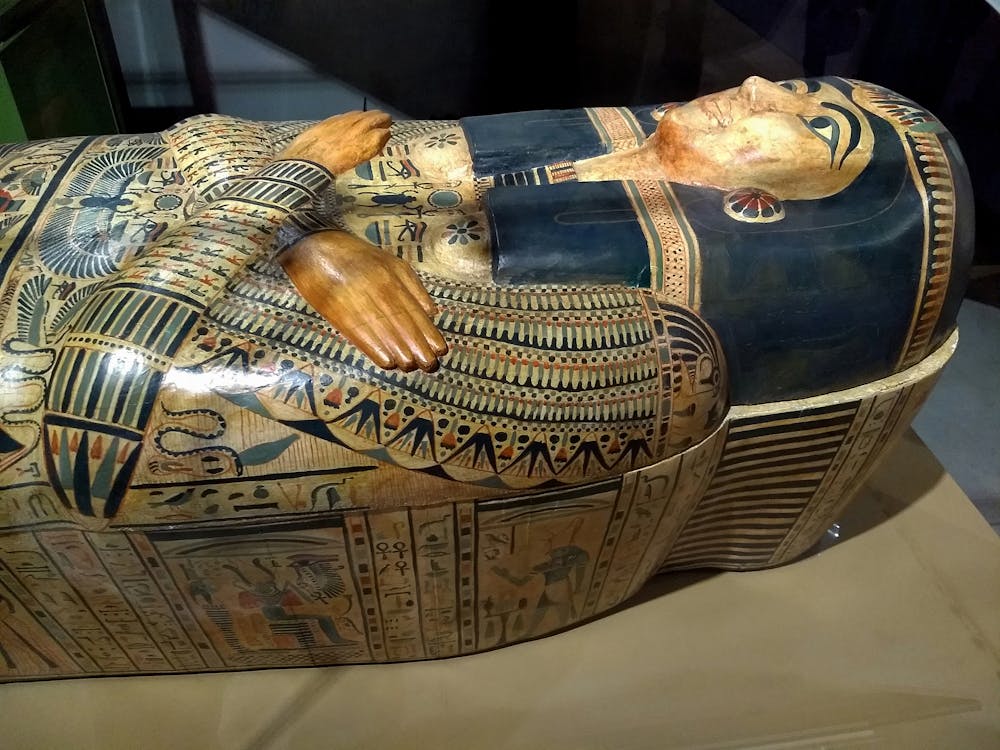The Marvels of Ancient Egyptian Tombs
Ancient Egypt, a civilization renowned for its rich culture, monumental architecture, and complex belief systems, is perhaps best known for its magnificent tombs. These structures, designed to honor the dead and facilitate their journey to the afterlife, offer invaluable insights into the society, religion, and artistry of the ancient Egyptians. This article explores the purpose, types, architectural features, funerary practices, and the significance of these tombs, shedding light on the intricate relationship between life and death in ancient Egypt.
The Purpose of Tombs
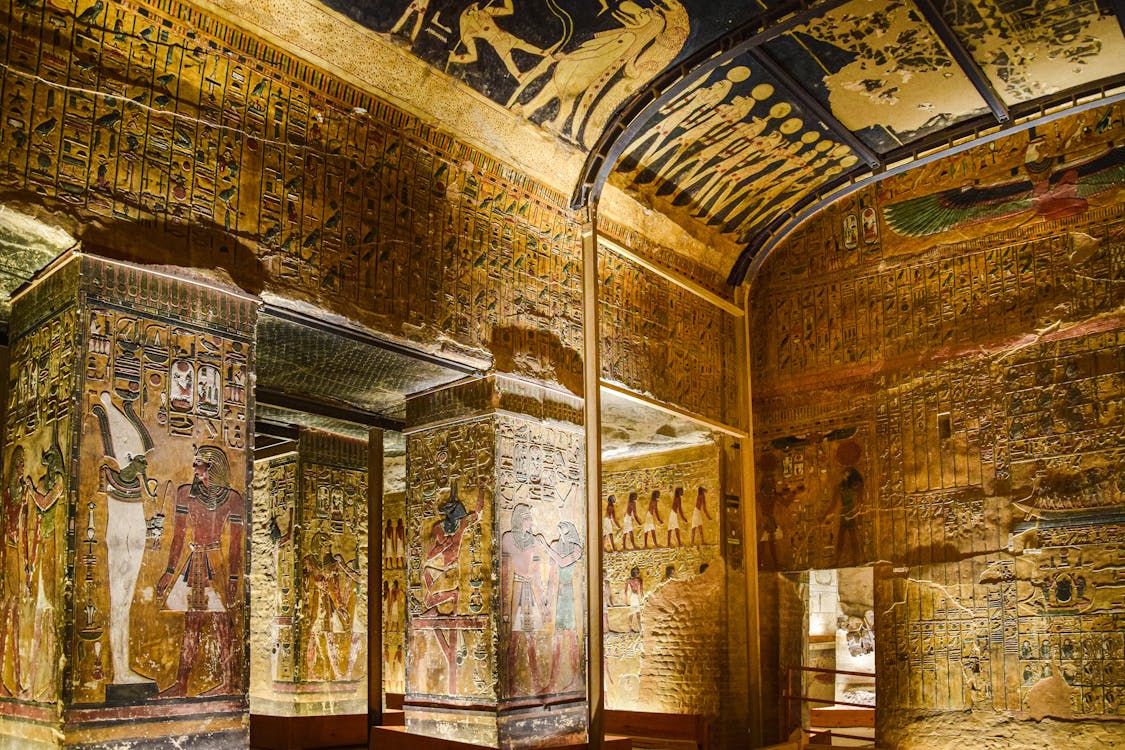
In ancient Egyptian belief, death was not the end but a transition to a new existence. Tombs were constructed as elaborate resting places for the deceased, intended to protect the body and ensure a successful journey to the afterlife. The Egyptians believed that maintaining the physical form was crucial for the soul’s survival, which comprised multiple components: the ka (spiritual double), the ba (personality), and the akh (the transformed spirit).
The tomb served as a physical dwelling for the ka, providing a place for offerings and a connection between the living and the dead. Rituals and funerary practices aimed to sustain the ka and ensure that the ba could travel freely between the worlds of the living and the dead. Thus, tombs were not only burial sites but also sacred spaces that reflected the society’s beliefs about immortality and the divine.
Types of Tombs:
The evolution of tomb architecture in ancient Egypt mirrors changes in religious beliefs, social structures, and available technology over thousands of years. Several distinct types of tombs emerged, each serving specific purposes and reflecting the status of the deceased.
- Mastabas: The earliest tombs, known as mastabas, emerged during the Early Dynastic Period (c. 3100–2686 BCE). These rectangular structures, with flat roofs and sloping sides, were typically made from mudbrick or stone. Mastabas served as burial places for the elite and often contained a burial chamber below ground. Inside, mastabas were decorated with reliefs and inscriptions that celebrated the deceased’s life, achievements, and aspirations for the afterlife. They frequently included offerings and provisions, reflecting the deceased’s social status and ensuring their comfort in the next world.
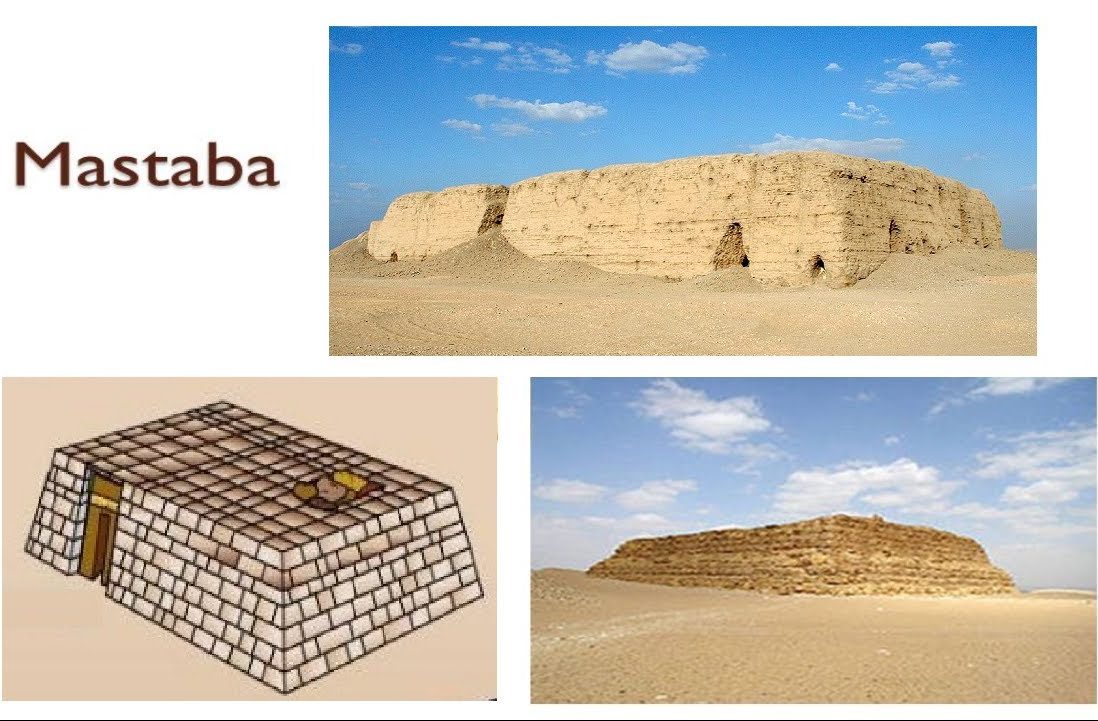
mastaba tomb
- Pyramids: The most iconic of all ancient Egyptian tombs, pyramids were built primarily during the Old Kingdom (c. 2686–2181 BCE). The Great Pyramid of Giza, constructed for Pharaoh Khufu around 2580–2560 BCE, is a testament to the architectural prowess of the time. Pyramids were designed to symbolize the pharaoh’s divine power and connection to the gods. These monumental structures featured complex internal layouts, including burial chambers and passageways. The pyramid’s shape represented the rays of the sun, symbolizing the pharaoh’s ascent to the heavens. Within, walls were adorned with intricate hieroglyphs and artwork that provided guidance and protection for the pharaoh in the afterlife.
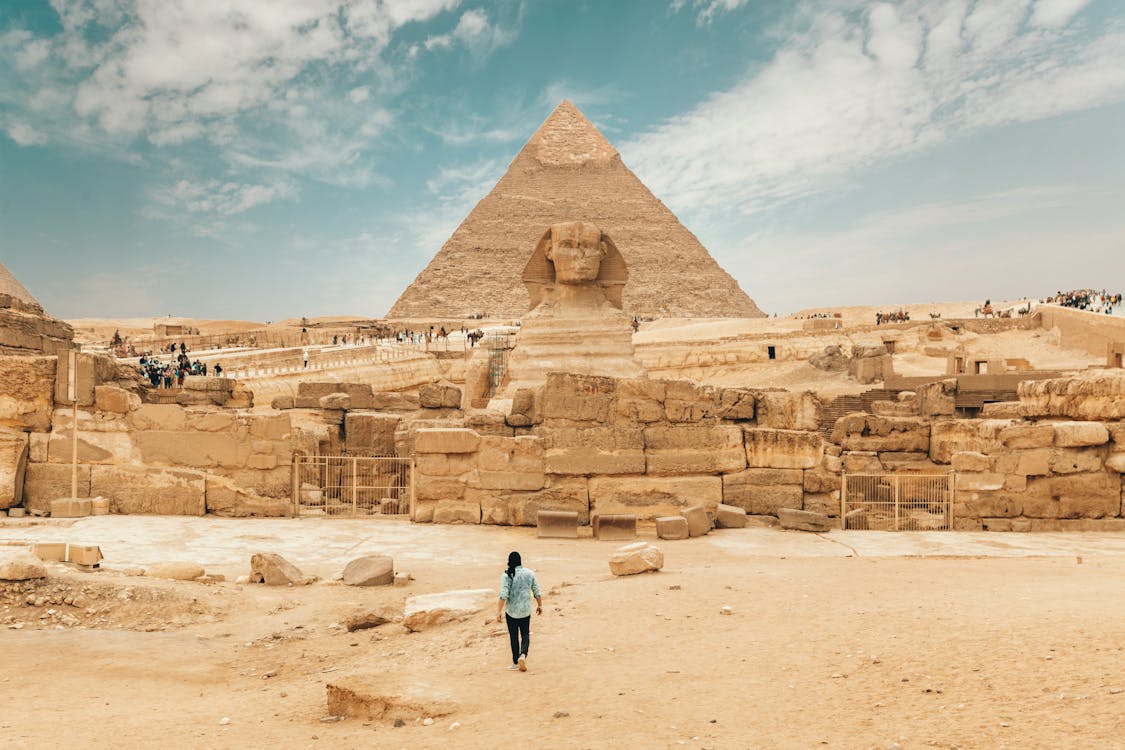
the Pyramids of Giza
- Rock-Cut Tombs: As the New Kingdom (c. 1550–1070 BCE) progressed, the design of tombs shifted to rock-cut structures, particularly in the Valley of the Kings. These tombs were carved directly into the mountainsides, allowing for more intricate designs and elaborate wall decorations. The Valley of the Kings is famous for the tombs of numerous pharaohs and nobles, including that of Tutankhamun. Rock-cut tombs typically included multiple chambers, such as antechambers, burial chambers, and storage rooms for goods. The walls were often covered in colorful frescoes depicting scenes from the deceased’s life, religious rituals, and images of deities. These artistic depictions provide invaluable insight into the beliefs and values of the time.
Architectural Features:
The design and construction of ancient Egyptian tombs were meticulous, with various features serving practical and symbolic purposes.
- Burial Chamber: The burial chamber was the heart of every tomb, where the deceased’s body was placed in a sarcophagus. This chamber was often adorned with elaborate decorations and inscriptions, intended to ensure the deceased’s safe passage into the afterlife. The sarcophagus itself was frequently made of stone or wood and might be intricately carved with protective spells and images of gods.
- Antechambers and Storage Rooms: Many tombs included antechambers used for storing offerings, personal items, and goods meant for the afterlife. These rooms could be filled with food, drink, tools, jewelry, and other items reflecting the deceased’s status and wealth. The more affluent the individual, the more elaborate and diverse the items placed within the tomb.
- Chapels and Mortuary Temples: Some tombs, especially those of pharaohs and high-ranking officials, included mortuary temples. These spaces allowed family members and priests to perform rituals and offerings, ensuring the deceased remained honored and remembered by the living. Chapels often contained statues of the deceased, creating a focal point for worship and connection between the living and the dead.
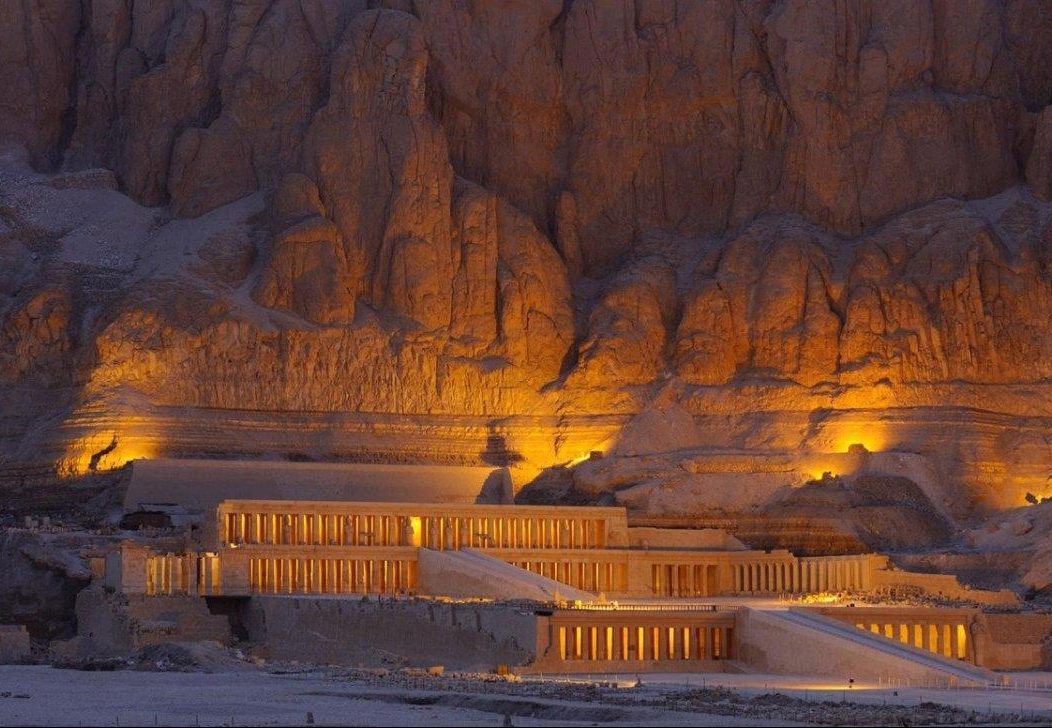
Mortuary Temple of Hatshepsut - Decorations and Inscriptions: The walls of tombs were typically adorned with intricate carvings and paintings, featuring scenes from daily life, religious rituals, and depictions of deities. Hieroglyphs provided prayers and spells designed to assist the deceased in their journey through the afterlife. The artistry of these decorations was not only a means of beautification but also served as a powerful expression of the beliefs and values of the society.
Funerary Practices:
The process of preparing a body for burial was an elaborate affair deeply rooted in religious beliefs and cultural practices.
- Mummification: Mummification was a critical component of the burial process, aimed at preserving the body for the afterlife. This involved the removal of internal organs, treatment of the body with natron (a naturally occurring salt), and wrapping it in linen. The goal was to ensure the physical form remained intact, allowing the ka to recognize its body in the afterlife.
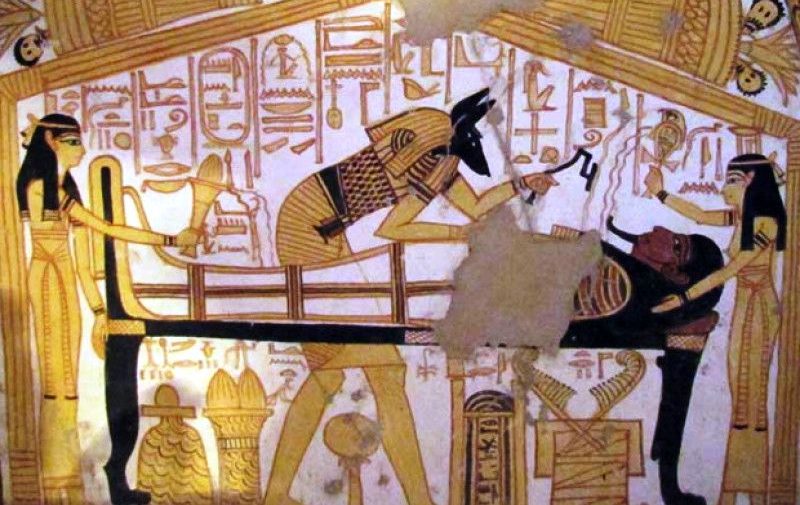
Mummification in ancient Egypt - Burial Rituals: Burial rituals were complex and varied, often led by priests who performed ceremonies, recited spells, and made offerings. These rituals honored the deceased and aimed to ensure a safe passage into the afterlife. Family members participated in these rites, demonstrating their love and respect for the departed.
- The Role of the Tomb in Funerary Practices: The tomb was central to these practices, serving as a sacred space where the living could connect with the deceased. Regular offerings were made at the tomb, and rituals conducted to sustain the deceased’s ka. The tomb became a bridge between the worlds, allowing the living to maintain a relationship with their ancestors.
Discovery and Archaeological Significance:
The discovery of ancient Egyptian tombs has profoundly impacted our understanding of this remarkable civilization. Over the past few centuries, archaeologists have unearthed numerous significant tombs, revealing a wealth of information about ancient Egyptian culture, religion, and daily life.
- Key Discoveries: One of the most famous discoveries is that of the tomb of Tutankhamun, uncovered by Howard Carter in 1922. This tomb contained an astonishing array of artifacts, including the iconic golden mask, chariots, jewelry, and everyday items. The discovery provided invaluable insights into the burial practices, art, and wealth of the New Kingdom pharaohs. Other significant sites include the Valley of the Kings, which has yielded numerous tombs of pharaohs and nobles, showcasing the evolution of tomb architecture and decoration over time. The tombs of Seti I and Ramses II are renowned for their elaborate wall paintings and inscriptions, reflecting the religious beliefs and artistic achievements of the period.
- Cultural Impact: The discoveries of ancient tombs have not only advanced our knowledge of history but have also sparked global interest in Egyptology. The treasures found within these tombs have captivated audiences worldwide, leading to exhibitions, documentaries, and continued research into ancient Egyptian culture. The allure of these discoveries has fostered a fascination that bridges ancient history and modern culture.
Cultural Legacy of Tombs:
The legacy of ancient Egyptian tombs extends far beyond their physical structures. They symbolize the profound relationship the Egyptians had with death, the afterlife, and their understanding of existence itself. Tombs were designed not only as resting places but also as reflections of the deceased’s life and aspirations.
A Window into Society
Tombs provide invaluable insight into the social structure of ancient Egypt. Differences in tomb size, design, and contents reveal much about the social hierarchies that existed, with pharaohs and nobles receiving elaborate burials while commoners were interred in simpler graves.
Artistic and Religious Expression
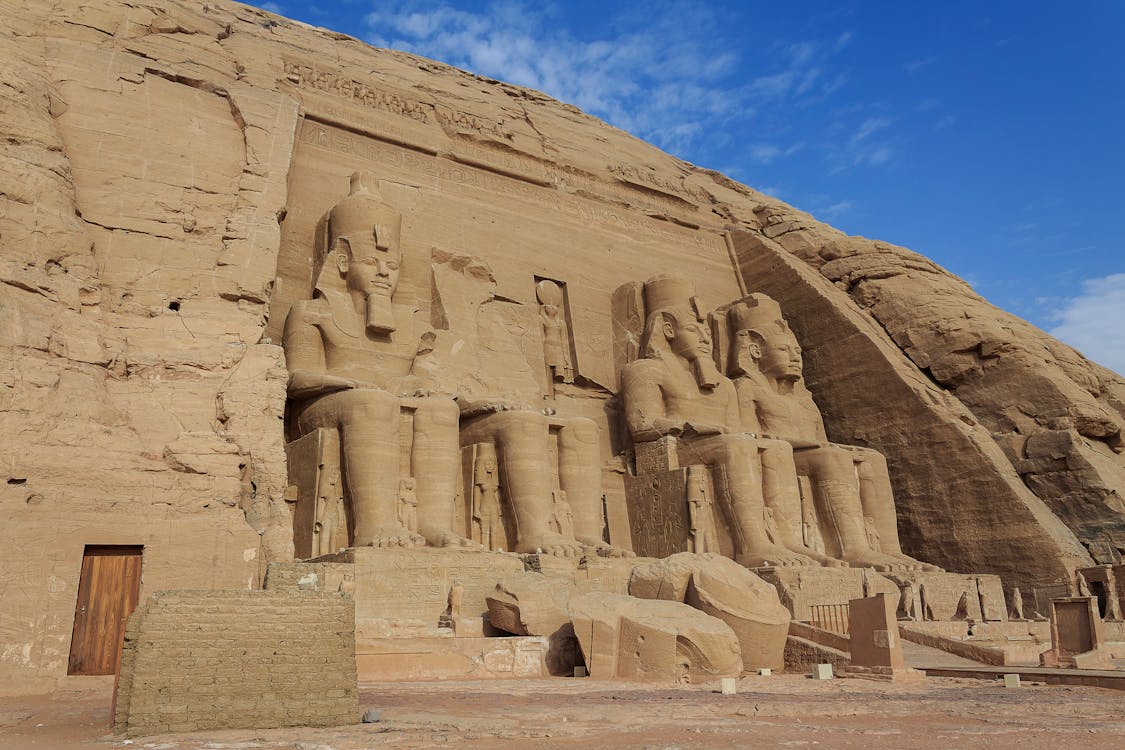
The art and inscriptions found within tombs offer a window into the beliefs, values, and practices of ancient Egyptians. They serve as a record of the society’s religious convictions, daily activities, and aspirations, preserving a narrative that continues to resonate with people today.
Modern Interpretations
Today, ancient Egyptian tombs continue to inspire artists, writers, and filmmakers, often serving as a backdrop for stories about mystery, adventure, and exploration of the afterlife. The allure of these tombs endures, fostering a fascination that bridges ancient history and modern culture.
Final Thoughts:
Ancient Egyptian tombs are remarkable structures that provide profound insight into one of history’s most captivating civilizations. They encapsulate the Egyptians’ beliefs about life, death, and the afterlife, reflecting their social structures, artistic achievements, and religious practices. As archaeological discoveries continue to unfold, our understanding of these extraordinary tombs—and the people who built them—only deepens. The legacy of ancient Egypt lives on through these monumental sites, inviting us to explore the mysteries of a civilization that continues to inspire and intrigue.

